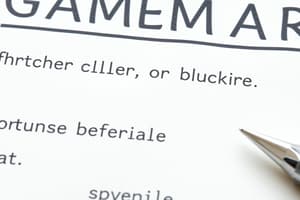Podcast
Questions and Answers
Which of the following is a type of simple sentence?
Which of the following is a type of simple sentence?
- Two independent clauses joined by a conjunction
- One independent clause (correct)
- At least one dependent clause
- At least two independent clauses and one dependent clause
An antonym is a word with a similar meaning.
An antonym is a word with a similar meaning.
False (B)
What part of speech replaces a noun?
What part of speech replaces a noun?
Pronoun
The three types of conjunctions are __________, __________, and __________.
The three types of conjunctions are __________, __________, and __________.
Match the punctuation mark with its use:
Match the punctuation mark with its use:
Which dialect of English is primarily spoken in the USA?
Which dialect of English is primarily spoken in the USA?
A compound sentence contains only one independent clause.
A compound sentence contains only one independent clause.
What is the smallest unit of sound in a language called?
What is the smallest unit of sound in a language called?
A __________ is a figure of speech that compares two unlike things using 'like' or 'as'.
A __________ is a figure of speech that compares two unlike things using 'like' or 'as'.
Which of the following best defines vocabulary?
Which of the following best defines vocabulary?
Flashcards are hidden until you start studying
Study Notes
English Language Overview
- Definition: A West Germanic language originating from England, now widely spoken globally.
- Dialects: Includes British English, American English, Australian English, and others, each with distinct vocabulary, pronunciation, and spelling.
Grammar
- Parts of Speech:
- Noun: Person, place, thing, or idea.
- Verb: Action or state of being.
- Adjective: Describes a noun.
- Adverb: Describes a verb, adjective, or other adverb.
- Pronoun: Replaces a noun.
- Preposition: Shows relationship between nouns/pronouns.
- Conjunction: Connects words, phrases, or clauses.
- Sentence Structure:
- Simple: One independent clause.
- Compound: Two independent clauses joined by a conjunction.
- Complex: One independent clause and at least one dependent clause.
- Compound-Complex: At least two independent clauses and one dependent clause.
Vocabulary
- Synonyms: Words with similar meanings (e.g., "happy" - "joyful").
- Antonyms: Words with opposite meanings (e.g., "hot" - "cold").
- Homophones: Words pronounced the same but with different meanings (e.g., "bare" - "bear").
Writing Conventions
- Punctuation:
- Period (.) - Ends a sentence.
- Comma (,) - Separates elements in a list or clauses.
- Question Mark (?) - Ends a question.
- Exclamation Point (!) - Indicates strong emotion.
- Capitalization:
- First word of a sentence.
- Proper nouns (names, places).
- Titles when used with names.
Literature
- Genres: Fiction, non-fiction, poetry, drama, etc.
- Elements of Fiction: Plot, character, setting, conflict, theme.
- Figurative Language: Metaphor, simile, personification, hyperbole.
Phonetics and Phonology
- Phonemes: The smallest units of sound in a language.
- Stress and Intonation: Patterns of emphasis in speech that affect meaning.
Language Skills
- Listening: Understanding spoken language.
- Speaking: Producing spoken language effectively.
- Reading: Comprehending written texts.
- Writing: Expressing thoughts in written form.
Common English Errors
- Subject-Verb Agreement: Ensuring subjects and verbs match in number (singular/plural).
- Tense Consistency: Keeping verb tenses uniform within a narrative or argument.
- Run-On Sentences: Avoiding overly long sentences that combine multiple independent clauses without proper punctuation.
English Language Overview
- A West Germanic language that originated in England, now spoken around the world.
- Major dialects include British, American, and Australian English, each featuring unique vocabulary, pronunciation, and spelling.
Grammar
- Parts of Speech:
- Nouns identify people, places, things, or ideas.
- Verbs describe actions or states of being.
- Adjectives modify nouns, adding descriptive detail.
- Adverbs modify verbs, adjectives, or other adverbs for clarification.
- Pronouns substitute for nouns to avoid repetition.
- Prepositions indicate relationships between nouns or pronouns.
- Conjunctions join words, phrases, or clauses together.
- Sentence Structure:
- Simple sentences contain one independent clause.
- Compound sentences consist of two independent clauses linked by a conjunction.
- Complex sentences combine one independent clause with at least one dependent clause.
- Compound-complex sentences feature at least two independent clauses and one dependent clause.
Vocabulary
- Synonyms are words with similar meanings, enhancing expression (e.g., "happy" is similar to "joyful").
- Antonyms are words with opposite meanings, useful for contrast (e.g., "hot" contrasts with "cold").
- Homophones are words that share pronunciation but differ in meaning (e.g., "bare" vs. "bear").
Writing Conventions
- Punctuation:
- A period (.) signals the end of a statement.
- A comma (,) separates elements in a series or clauses for clarity.
- A question mark (?) indicates a query.
- An exclamation point (!) conveys strong emotions.
- Capitalization:
- The first word of sentences and all proper nouns must be capitalized.
- Titles should be capitalized when used with names to denote respect.
Literature
- Major genres include fiction, non-fiction, poetry, and drama.
- Key elements of fiction encompass plot, character, setting, conflict, and theme development.
- Figurative language employs devices like metaphor, simile, personification, and hyperbole for added depth.
Phonetics and Phonology
- Phonemes are the smallest units of sound that can change meaning.
- Stress and intonation patterns convey meaning through emphasis in speech.
Language Skills
- Listening involves accurately interpreting spoken language.
- Speaking includes effectively articulating thoughts verbally.
- Reading entails understanding and processing written material.
- Writing focuses on clearly expressing ideas in written format.
Common English Errors
- Subject-verb agreement: Ensure that the subject and verb match in number (singular or plural).
- Tense consistency: Maintain uniform verb tenses throughout narratives or arguments for clarity.
- Run-on sentences: Avoid combining multiple independent clauses without appropriate punctuation to ensure readability.
Studying That Suits You
Use AI to generate personalized quizzes and flashcards to suit your learning preferences.




